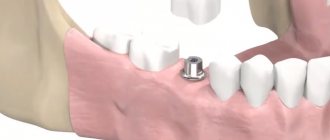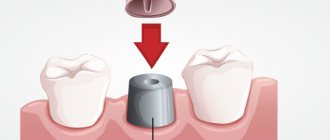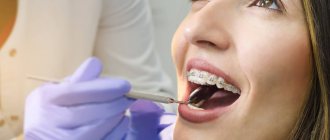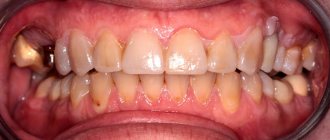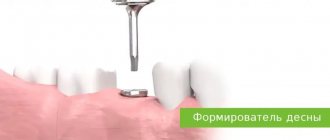What is dental implantation When do you need an alternative How can you replace implants For chewing teeth For front teeth With complete edentia Why do you need to restore teeth Which method is better
Patients are looking for an alternative to implantation due to financial or clinical restrictions on the implantation of artificial roots. Removable dentures (clasp, flexible, acrylic) and fixed products made of metal ceramics, all-ceramic, zirconium (dental bridges) can not fully replace implants. Rarely, missing units are replaced by displacing adjacent ones using braces. The preferred option is implantation: it guarantees an aesthetic, long-term and reliable result, with safety for neighboring units and benefits for the jawbone.
When should dental implants not be performed?
Implantation has a number of contraindications, including the following problems and pathologies:
- diseases of the blood and hematopoietic organs, connective tissue of a systemic nature (lupus erythematosus, rheumatic and rheumatoid conditions);
- malignant neoplasms (sarcoma, carcinoma, melanoma);
- pathologies of the central nervous system, immune system (for example, HIV), oral cavity (chronic aphthous stomatitis, pemphigus);
- type 1 diabetes mellitus;
- tuberculosis.
Temporary contraindications for dental implantation are infectious diseases in the acute stage, pregnancy, drug addiction (implantation is possible after treatment and stable remission for 5 years), condition after radiation therapy. Relative contraindications are bruxism (the habit of grinding teeth), malocclusion, gingivitis, arthrosis or arthritis of the temporomandibular joint, bad habits, poor oral hygiene.
Stages of dental treatment and prosthetics
Before prosthetics, it is important to create a reliable support for future dentures, so first we carried out the removal of old crowns, an inspection of all teeth by an endodontist, high-quality treatment of those teeth that can be saved, and the removal of teeth that cannot be restored.
An endodontist performs dental treatment under a microscope, which allows you to save even the most seemingly hopeless teeth, so tooth extraction is carried out only as a last resort. When treating teeth under a microscope, the quality of treatment increases significantly, which is especially important when treating teeth that will be covered with crowns.
To treat root canals, old fillings are removed, the canals are thoroughly cleaned to eliminate the presence of infection, and then filled with reliable modern methods (these stages are shown in the photo).
All manipulations are carried out using a rubber dam, which makes the treatment better, since the filling area is absolutely dry, and comfortable, since the patient is relieved of dry mouth due to the constant operation of the saliva ejector, the ingress of medications and other unpleasant sensations.
Telescopic crowns were installed on the upper front teeth, on which the removable denture will be fixed.
The lower teeth are aligned for proper bite. Ceramic veneers were installed on the lower front teeth.
Dental implantation was performed in the lower jaw using bone grafting. The method of pain relief during surgery is sedation. Next, prosthetics was performed on implants using ceramic crowns.
Prosthetics with telescopic crowns instead of implants
A comfortable alternative to dental implants are dentures mounted on telescopic crowns, which are inserted into one another, resembling the retractable parts of a telescope. Refers to the type of clasp dentures, which are based on a metal frame. They consist of 2 parts - removable, which includes the base with crowns, and non-removable, that is, the crown itself, reminiscent of a thimble. It is fixed with medical cement to the supporting element. When connecting, the second part of the prosthesis is put on the first part and the product is firmly fixed. The crowns on such a prosthesis are made cylindrical and conical. Main advantages:
- uniform distribution of chewing load and pressure on the supporting teeth, preventing injury to the gums and periodontal tissues;
- reliable fixation, with the help of which the prosthesis does not fall out and ensures its immobility;
- incredible strength, since the structure is made of an alloy of palladium, gold, cobalt and chromium;
- good accessibility of interdental spaces when removing the product, allowing for complete cleaning.
Galvanic technology is also used in production. It lies in the fact that the structure is made from alloys of base metals or zirconium dioxide, applying gold to the outside. The surface is covered with composite materials.
Contraindications include the patient’s lack of supporting teeth, malocclusion, low palate, respiratory disease, inflammatory processes in the oral cavity, and pregnancy.
Important! The structure can often be left in place. It is enough to remove it from the oral cavity once every 2-3 months for hygienic cleaning.
Possibilities of a conditionally removable denture supported by natural teeth
A fixed bridge supported by your own teeth will help replace 1 to 4 missing teeth in a row. The undoubted advantage of such dentures is a better restoration of chewing function compared to removable dentures, the absence of discomfort and good aesthetic characteristics. Bridges do not need to be maintained or adjusted: up to a certain point, the patient may not notice them at all. Of course, this design will also cost significantly less than an implant-supported prosthesis. But there are some nuances here too.
✔
With a classic bridge, only a few teeth can be restored, because the supporting teeth also need to be taken into account. For example, to replace 1 tooth, the patient is given a prosthesis on 2 supporting teeth.
✔
Abutment teeth (even completely healthy ones) must be ground down for crowns.
✔
In this case, the tissues surrounding the tooth, the so-called periodontium, have an increased chewing function, taking on the load of the missing tooth. Over a long period of operation, the reserve forces of the periodontium of the supporting teeth will weaken, which, as a consequence, sooner or later will lead to their loss. That is why the service life of bridges, as a rule, does not exceed 7-10 years.
Fixed prosthetics instead of implants
An alternative to dental implantation involves the manufacture and wearing of permanent dentures. In dental practice, several types are used to solve the problem:
- Veneers. Made from porcelain, zirconium or composite materials. They are a thin plate that is glued with special cement to the front of the teeth. Due to the properties of the materials, they are strong and durable. They are used primarily for aesthetics if the tooth is chipped, has cracks or other defects. The prosthesis can be chosen in any shade; it looks natural, does not fade or stain.
- Tabs. They are used as an alternative to dental implantation if the coronal part is significantly damaged, but the root is healthy. To restore chewing function, microprosthetics are performed. This is a special tab that fills the cavity of a damaged tooth. It does not shrink, prevents the risk of secondary caries, and recreates the natural shape and shade as accurately as possible.
- Crowns. They consist of a metal frame (cobalt, chromium, nickel, gold, platinum) coated with a ceramic solution. The ceramic composition is applied in layers, each of which is processed at a temperature of +850 degrees Celsius. Crowns can be used to replace chewing teeth, since the composition of the materials can withstand significant loads. There are no allergies to artificial teeth, bacteria do not multiply and do not affect neighboring teeth, and their service life is more than 10 years.
- Bridges. Instead of implantation, they are used in the absence or defects in the lateral and anterior sections of 4 or fewer teeth. Several varieties are produced. These are metal ones that are highly durable, but can destroy neighboring teeth. Metal-ceramic - are a metal frame with a ceramic crown part. Plastic - made from acrylic, do not cause allergies, lightweight, durable, used primarily as temporary structures. Zirconium crowns are ceramic crowns based on zirconium dioxide. Durable, exert minimal pressure on supporting adjacent teeth, biocompatible, hypoallergenic.
In general, non-removable structures are durable (will last 7-20 years), are firmly fixed, have a natural appearance, and are easy to adapt to. Contraindications to the procedure are extreme exhaustion (cachexia), oncology, drug addiction, undergoing drug or radiation therapy, acute diseases in the oral cavity or the whole body, pregnancy.
This is interesting: Installation of inlays is recommended if the coronal part is damaged by 25-50%. In this case, filling does not solve the problem.
About implant brands and price differences
The most expensive implants are those made in Europe and the USA, but this does not mean that they have no alternative. We recommend paying attention to South Korean implants. Many are quite skeptical about products from Asia, but the medical industry of South Korea is not inferior to leading Western countries in terms of technological solutions. One of the best South Korean implant systems is Osstem. The company offers a wide range of implants and abutments that can solve the problem of partial and complete tooth loss in patients of various age and social groups. The possibility of 3D planning and the availability of special sets of tools for installing Osstem implants in conditions of bone deficiency makes it universal.
It is very important that the selected company producing implants has a distributor in your city who would not only sell this system, but also conduct courses, seminars, master classes and provide all the necessary technical support to doctors and patients. There is no need to save on your health by trusting systems that have not received a license and do not have official representation in Russia.
Removable prosthetics - replacement of implants
An alternative to a dental implant can be the installation of removable dentures. These structures are completely removable when you need to restore the entire dentition. Since it is not possible to strengthen them on the supporting teeth, alternative methods of fixation are used. Partially removable dentures are fixed using attachments - special hooks. This prosthetic option, instead of implantation, is suitable if it is impossible to install bridges. To restore chewing function, the following types of removable structures are used:
- Bugelnye. They consist of ceramic or metal-ceramic crowns mounted on an arch made of nickel and chrome. They are fixed to adjacent supports using clasp locks. They are distinguished by their structural strength, which does not become loose over time. When worn, the prosthesis does not cover the palate, and therefore does not affect taste and diction. They prevent atrophy of the jaw bone tissue, since they correctly distribute the load and restore chewing function. Can last 10 years.
- Nylon. Made from soft nylon, with holes for remaining teeth. Thanks to the vacuum created on the upper jaw, the structure fits tightly. The prosthesis does not cause allergies in the patient and is an alternative to clasp prosthetics if the patient has metal intolerance. The color of the base is identical to natural fabrics, so the design looks natural. Nylon is soft and lightweight, so the denture does not put pressure on the jaw and does not cause discomfort. The service life is 5-8 years.
- Bioplastic. Made from silicone or propylene. They fit tightly to the palate, creating the feeling that the prosthesis has been sucked in. The model for restoring the dentition is created individually and therefore does not require additional fixation. If the tightness of the seal needs to be strengthened, special pastes and gels are used.
- Acrylic. The base is made of plastic (acrylic), on which the crowns are installed. The alternative to implantation is divided into 3 types - complete, which replace all bone formations and are fixed like a suction cup. Partial - replace several lost bone formations and are fixed with clasps. “Butterfly” - placed in the place of 1 lost bone formation, attached to the adjacent ones. The product is lightweight, correctly distributes the load on bone formations, is easily cleaned of dirt, and the shade completely imitates a real jaw. They are used primarily as a solution to a problem for a short time, since their service life is 2.5-5 years.
- Acry Free. These are dentures made of synthetic material that do not contain acrylic. It is soft, elastic, but strong enough and can restore an entire row of teeth or partially lost teeth.
- Quattro Ti. Instead of implantation, designs that are comfortable to wear are suitable. In terms of functionality, they are close to clasp ones, but do not contain metal. The base is Dental D material, which has hypoallergenic qualities, is durable, resistant to mechanical and physical stress. It restores and imitates gums and crowns well, so the patient’s smile has a beautiful aesthetic appearance.
Along with temporary dental structures, immediate dentures are used, which are installed immediately after removal of the masticatory organ or before preparing for permanent prosthetics. In general, this alternative to implantation is contraindicated for patients with allergies to synthetic materials or metal, with increased tooth mobility, and bite defects.
Which method is better to choose?
Implantation is a privileged way to restore lost elements in the absence of financial and clinical restrictions. Advantages of the method:
- Implants are durable. When installing a dental bridge, a replacement will be required after 5-7 years. The service life of implants is at least 25 years .
- Adjacent elements remain untouched. Implants do not require support. When installing a dental bridge, the supporting units are pre-ground, which leads to their destruction.
- Stopping bone atrophy. Implantation guarantees an even chewing load on the jawbone - the bone is not destroyed.
- Preservation of taste sensations. Removable structures dull the sense of taste due to the massive base blocking the receptors.
- Reliable fixation of prostheses and installation of various options for orthopedic structures.
Author of the article Voznyuk Vladimir Aleksandrovich Maxillofacial surgeon-implantologist of the highest category
Experience more than 30 years
Combined prosthetics - an alternative to implants
As an alternative to implants for restoration, structures consisting of a removable and a stationary part are used. The non-removable element is attached with dental cement to the patient’s real bone formations, and is connected to each other with clasps, attachments or telescopic crowns. They are used instead of implantation for restoration in the absence of a large number of chewing organs, in case of periodontal disease, if there is increased looseness of bone formations. Or if the patient does not want to grind down the supporting teeth to install a bridge.
When to change
After implantation, you should visit your dentist every 6 months. As soon as a specialist detects signs of product rejection or sees that the design no longer meets quality requirements, a decision is made to remove and possibly replace the structure.
Changing the implant is necessary if:
- pin mobility;
- severe pain at the attachment site;
- bleeding;
- severe swelling;
- signs of suppuration;
- swelling of the face in the area of implant installation.
If the patient himself notices such signs, then he should contact a specialist immediately. Similar symptoms can occur both in the first days and years later.
Replantation instead of implants
replantation
This is a fairly rare procedure instead of implantation, where the restoration element is the patient’s own tooth. When treating chronic periodontitis or in case of tooth trauma, for example, dislocation, the bone formation is removed and after the therapy is returned to its place. In this case, the organ is preserved (preserved), and implantation or installation of a removable device is not required. Much depends on the degree of integrity of the bone formation and the condition of the oral cavity. The implanted replant can last about 20 years.
First, the patient’s lost tooth is treated with antiseptic solutions. The hole is then cleaned with a curettage spoon, which removes debris and damaged structures. After this, the prepared bone formation is installed in the hole. At the final stage, a splinting device is installed, which fixes the bone formation in a stationary state. The wearing time for the splint is 4-6 weeks.
The procedure is performed under local anesthesia. Indications for surgery:
- the appearance of holes in the tooth root;
- jaw injury resulting in tooth loss;
- a purulent-inflammatory process in the periosteum.
Contraindications to the restoration procedure are diabetes mellitus, disorders of the cardiovascular system, oncology, severe inflammation of the mucous, gum and bone tissues of the oral cavity, acute viral and infectious diseases, and pathologies of the hematopoietic system.
Important! If a bone formation has fallen out, it is unacceptable to store it at home. This leads to its damage, and after installation, rejection may occur.
The role of the doctor in choosing a treatment method
Often, already at the first consultation, the patient categorically declares: “I need an implant!” It sounds so confident that it seems that only the lack of appropriate tools is keeping the patient from doing it himself.
Before receiving the right to treat patients, a doctor studies for 6 years, then for 2 years he can undergo highly specialized training. Every 5 years he goes to improve his qualifications, but in fact he studies all his life, constantly gaining new experience, skills and knowledge. What can be concluded? Only a doctor can draw up an optimal rehabilitation plan and carry out the necessary manipulations.
Before starting treatment, a comprehensive clinical and radiological examination is carried out, and if necessary, the patient is referred for consultations to doctors of related specialties. Not only the extent of the dental defect is assessed, but also the condition of each remaining tooth, the quantity and quality of bone tissue, and the presence and severity of the patient’s general diseases. Only then will it be possible to make a diagnosis and formulate a treatment plan. Of course, the patient should be fully informed about both the treatment plan and alternative methods.
In conclusion, we would like to advise patients who have not decided on the choice of treatment method and who have no serious contraindications to pay attention to dental implants.
Orthodontic treatment
As an alternative to implant prosthetics, the dentist may offer orthodontic treatment with a braces system. The defect of missing lateral teeth is eliminated by moving the remaining bone formations. The method is used after a thorough examination of the patient, diagnosis and when the bone tissue is in good condition. To change the position of bone formations and “close” the hole in the dentition, braces are installed in the area of the defect. However, this method of recovery does not always give the desired result.
Why is it necessary to restore teeth?
Displacement of adjacent teeth to the site of a previously removed one.
In case of single, segmental defects of a row or complete edentia, the patient should be consulted about restoration, since the integrity of the dentition affects the health of the whole organism.
The absence of one, several or all teeth provokes:
- displacement of surviving units;
- row curvature;
- bite pathologies;
- rapid damage to remaining teeth;
- bone tissue atrophy;
- sagging gums;
- diction violations.
Due to improper load distribution, the trophism of bone tissue deteriorates and the contours of the facial skeleton change. Premature manifestation of signs of aging in the form of deformation of the oval of the face and the formation of wrinkles is possible.
Dental defects create communication problems, give rise to complexes and reduce the patient’s quality of life.
Implantation allows you to prevent all negative consequences. However, this method requires surgery and the use of expensive materials.
Ways to extend the life of dental appliances
In order for structures to last longer, you need to properly care for them. To do this, you should follow the following rules:
- Cleansing. Removable devices are washed with running water, paying attention to stuck food particles and plaque. The procedure is performed with a special non-abrasive paste and a soft brush. The direction of movement is from top to bottom (similar to cleaning implants). An irrigator with a curved tip is suitable for these purposes, with which you can remove dirt from the smallest elements.
- Cleaning the oral cavity. In partial dentures, the bone formations are cleaned with paste and a toothbrush. You can use floss. You also need to clean your tongue and palate. For permanent prosthetics, a special brush with soft silicone spikes is used.
- Antiseptic treatment. There are special tablets that should be dissolved in water and the removable device should be washed with the resulting solution. This composition will wash away the remnants of the fixing agent, plaque, and eliminate pathogenic bacteria. At home, a container with ultrasound is used to clean the device.
- Storage. To prevent the product from deteriorating, it should be stored outside the oral cavity in a container with a hermetically sealed lid that will protect it from scratches and impacts.
It is better to avoid sticky and viscous foods so as not to disturb the fixation. It is advisable not to take too hard food, as the artificial substitute may break down, and this can lead to injury to the oral mucosa. Rinsing with boiling water or drinking hot drinks is also contraindicated, since the dental product may become deformed.
Important! If the product is broken, it is strictly forbidden to repair or restore it yourself. Improvised means or industrial glue can cause intoxication of the body, and an incorrectly fitted device can rub or injure the gums.
Complications after installation
A prosthesis or bridge, as well as other prosthetic methods, can cause complications. Most often, negative consequences for the patient are a consequence of failure to follow medical recommendations.
After installation of implants, complications are possible in 5% of cases, and doctors carefully warn patients about their occurrence. After the operational stage, you may encounter the following consequences:
- heavy bleeding;
- seam divergence;
- strong pain;
- perforation of the maxillary sinuses;
- partial paralysis of the masticatory muscles due to damage to the mandibular nerve;
- inflammation at the site of installation of the artificial root;
- implant failure due to peri-implantitis.
To prevent possible complications, the patient receives recommendations on proper wound treatment and oral hygiene. If any discomfort occurs, you should consult a doctor.
Placing bridges is a less invasive procedure. But it can also be accompanied by a number of complications, including the following:
- Discomfort. Unpleasant sensations can be associated with soreness (rubbing, pressing) and with food getting under the prosthesis if it fits incorrectly.
- Excessive convexity of the prosthesis. The patient gets the impression that something is bothering him. May cause the bridge to split in the area of the supports.
- Exposing the neck of the tooth. The process of receding gums does not occur immediately, but can be accelerated due to the patient’s illness or improper (usually excessive) grinding of the teeth.
- Breakage of crowns. Characteristic of patients who suffer from bruxism. Due to the mechanical impact, the crowns become detached from the base.
- Tooth decay under a bridge. The supporting teeth are hidden by the prosthesis, so it is difficult to track their condition.
The choice of prosthetics should be based on the condition of the oral cavity.
How much do implant alternatives cost?
The price depends on the selected type of product, manufacturing materials, the scale of the problem and the work of the specialist, the status of the clinic and the experience of the doctor. Costs may vary depending on additional procedures and tests (such as x-rays).
Calculator: calculate prices online
Turnkey implantation
Calculate the cost of turnkey dental implantation yourself.
The price includes: the implant itself + installation work + consumables + gum former. Select an implant
0
Specify the required number of implants
Select crown type
+Installation of an abutment on the implant is additionally paid: 1 abutment is required for one crown. The cost of 1 abutment is 4000 rubles.
Installation of an implant with simultaneous tooth extraction. If it is necessary to install an implant, remove the tooth first and immediately place the implant. Cost 5000 rub.
Specify the number of deletions
Better and more accurate - in a free consultation! All addresses and telephone numbers are on the website chudostom.ru. Make an appointment by calling the branch closest to you.
The calculation is not a public offer; the final cost is determined at a free consultation BEFORE the start and does not change during the treatment process.
Total cost rub.
About the disadvantages of implantation
From the outside, implantation may seem like an ideal technique, and in many ways it is - with the exception of a few points. The disadvantage of implantation is not only the high price, but also limitations during the procedure. There are a number of contraindications in the presence of which dental implantation is not recommended or cannot be carried out in principle. In case of absolute contraindications, alternative methods remain the only option.
If a sufficient volume of bone tissue is preserved, prosthetics on dental implants does not present any difficulties and allows the patient to obtain the maximum expected functional result and better aesthetics.
In cases where the volume of bone tissue does not allow the installation of an implant, additional osteoplastic operations are required to restore it. In some cases, plastic surgery of the gingival margin may be required, especially if the patient has high aesthetic needs. In the postoperative period, soft tissue swelling and pain are possible.
If treatment is carried out according to the classic two-stage protocol, the implant is installed in the bone tissue, and sutures are placed on the mucous membrane above it. After surgery, the healing process (waiting for the implant to integrate into the bone) can take from several weeks to several months. Then the second stage, additional surgery, is performed. The implant is opened, the external parts are fixed on it, and the orthopedic stage of treatment begins, the manufacture of the actual dentures. Not everyone is ready to wait that long.
There are options for installing an implant during tooth extraction and immediate fixation of a temporary prosthesis on the installed implant. The choice of technique is made by the doctor, based on each specific case.
Pin or implant? What to choose?
What is an implant
What is a pin and how is it different from an implant?
How does a pin differ from an implant?
Pin or implant? This question worries many who decide to restore lost teeth. To make a decision, it is important to understand the difference between these designs. Both the post and the implant support the crown. However, they perform different tasks and are installed in different clinical situations. Let's take a closer look at each of them.
The result of dental prosthetics
Eight specialists from the center took part in the work. They all acted in concert, according to a plan approved by the attending physician and the patient before the start of treatment. Thus, the patient knows what result awaits him, knows how much money will be needed for treatment and how long it will take. This approach has a beneficial effect on treatment, reducing the stress of undergoing treatment. The result is effective prosthetics and restoration of the health of the dental system.
Doctors who participated in this treatment:
- Chief physician of Dial-Dent S.V. Zukor - coordination of doctors, calculation of estimates, dental prosthetics.
- Implant surgeon V.P. Alaverdov – dental implantation, bone grafting.
- Anesthesiologist M.S. Vakhrameev - sedation during dental implantation.
- Dentist-endodontist Yu.A. Borisova - dental treatment with a microscope.
- Osteopathic doctor T.Z. An - osteopathic treatment support.
- Dental technician E.N. Golovin - production of telescopic removable dentures.
- Dental technician D.V. Wolf - production of ceramic veneers and crowns.
- Hygienist E.P. Smirnova - hygienic support of complex treatment.
All information about the complex complex treatment performed is recorded on a memory card and given to the patient.
See other examples of the work of Family Dental specialists here.
Implantation with immediate loading –
Immediate-load implantation involves crowns or bridges being secured to implants either immediately after surgery or within the first 72 hours after surgery. Thus, it turns out that the process of implant integration (their fusion with the bone) will take place in full under conditions of chewing load. Accordingly, this increases the risks, thereby increasing the requirements of the implantologist for the selection of implants, as well as the requirements for the density and volume of bone tissue in the implantation zone.
1) Immediate load in case of partial absence of teeth –
Most often, this technique is used in the absence of 1 tooth in the aesthetic zone (most often in the area of the lower incisors). In this case, immediate loading assumes that a temporary crown made of plastic or composite material will be made and fixed to the implant within the first 2-3 hours after the operation. It should be noted that the temporary crown in this case is slightly removed from the bite so that the implant does not experience a pronounced chewing load.
The best option for a temporary crown would be a plastic crown made by milling (CAD/CAM technology). Such a crown will be as precise as possible, this will make it possible to form an ideal gum contour around the implant neck, and also reduce the risk of developing peri-implantitis. But temporary plastic crowns made from an impression or from a composite material have a lot of disadvantages in this regard.
Immediate load prosthetics are more often used for single missing teeth in the lower jaw due to the fact that the lower jaw has denser bone (types D1 or D2), which allows for good primary stability of the implant immediately after its installation. The upper jaw has softer bone types D3 or D4, and therefore a newly installed single implant will not have sufficient primary stability (24stoma.ru). Therefore, in the area of the front teeth of the upper jaw, this method is used - when it is necessary to install several implants in a row + a temporary bridge is made.
Clinical case No. 1 –
Stage 1 – installation of the implant with immediate fixation of the temporary crown.
The second stage is permanent prosthetics (after 8 weeks).
Important: this method allows you to obtain acceptable aesthetics immediately after surgery, as well as create a beautiful gingival contour around the implant. But! You must understand that in this case, the risk of developing inflammation and bone resorption around the neck of the implant, and even complete rejection of the implant, will be much higher. Consent to this technique is a matter of your trust in the doctor + your confidence in his experience and professionalism. In addition, with immediate loading, you should not skimp on the quality of implants. Here you need implants with an ultra-hydrophilic surface, for example, Straumann (Switzerland) or Nobel Biocare (Switzerland).
2) Immediate load in case of complete absence of teeth -
There are 2 implantation methods for complete absence of teeth in the jaw, allowing the patient to receive a completely permanent bridge prosthesis – within 72 hours after surgery (on days 2-3). Here you just need to clarify that in most cases, at first it will be possible to make only a temporary bridge from metal-plastic, but after six months to a year you can replace it with a permanent bridge, for example, from metal-ceramic. But nevertheless, even with a temporary bridge, you can immediately chew, and it will have quite acceptable aesthetics.
- Basal implantation technique - in patients with complete absence of teeth, the bone tissue of the jaws is significantly atrophied, and its volume is not enough to install classical implants. In this case, so-called “basal implants” are used, which are installed in the deeper basal layer of the bone, which in 90% of cases makes it possible to do without bone grafting. The cost of installing 8-12 basal implants + a temporary bridge made of metal-plastic will be from 230,000 rubles for 1 jaw (turnkey, for 2021).
How basal implantation is performed: video
- Implantation according to the All-on-4 or All-on-6 protocols - the All-on implantation concept was developed by the implant manufacturer Nobel-Biocare (Switzerland), and it implies that a fixed bridge prosthesis will be fixed, respectively, only on 4- x or 6 implants. The Nobel-Biocare company has developed special implant models for this - “Nobel-Parallel CC”, “Nobel-Speedy Groovy”, as well as “Nobel-Zygoma”.
The cost of the All-on-4 technique (with the installation of 4 Nobel implants of the indicated types) and a temporary bridge made of metal-plastic will cost you from 370,000 rubles. A temporary bridge is also installed 2-3 days after surgery, but in this case, after 4-5 months it can be replaced with a permanent one, for example, made of metal ceramics. It should also be noted that when using Nobel implants, in some cases it is possible to immediately install a permanent metal-ceramic bridge, bypassing a temporary structure.Implantation using the All-on-4 protocol –
To make this technique more accessible, a number of implantologists suggest installing not Nobel implants specially designed for this, but budget implant models - MIS, AlphaBio, Osstem, etc. In this case, the cost becomes significantly lower, but it should be noted that such implants were developed for completely different purposes and, as a rule, pronounced bone resorption is observed around them + not very good long-term results. Read more about the methodology at the link above.
Important: it’s probably worth saying that the use of All-on-4 or All-on-6 is less justified in smokers and older patients (due to the more traumatic operation of the operation) - compared to the basal implantation technique. In addition, it should be noted that in both cases, the turnkey cost is always calculated taking into account the temporary bridge. When you decide in six months or a year to replace the temporary bridge with a permanent one, then such a replacement with a permanent metal-ceramic bridge will cost you about another 180,000 rubles.
